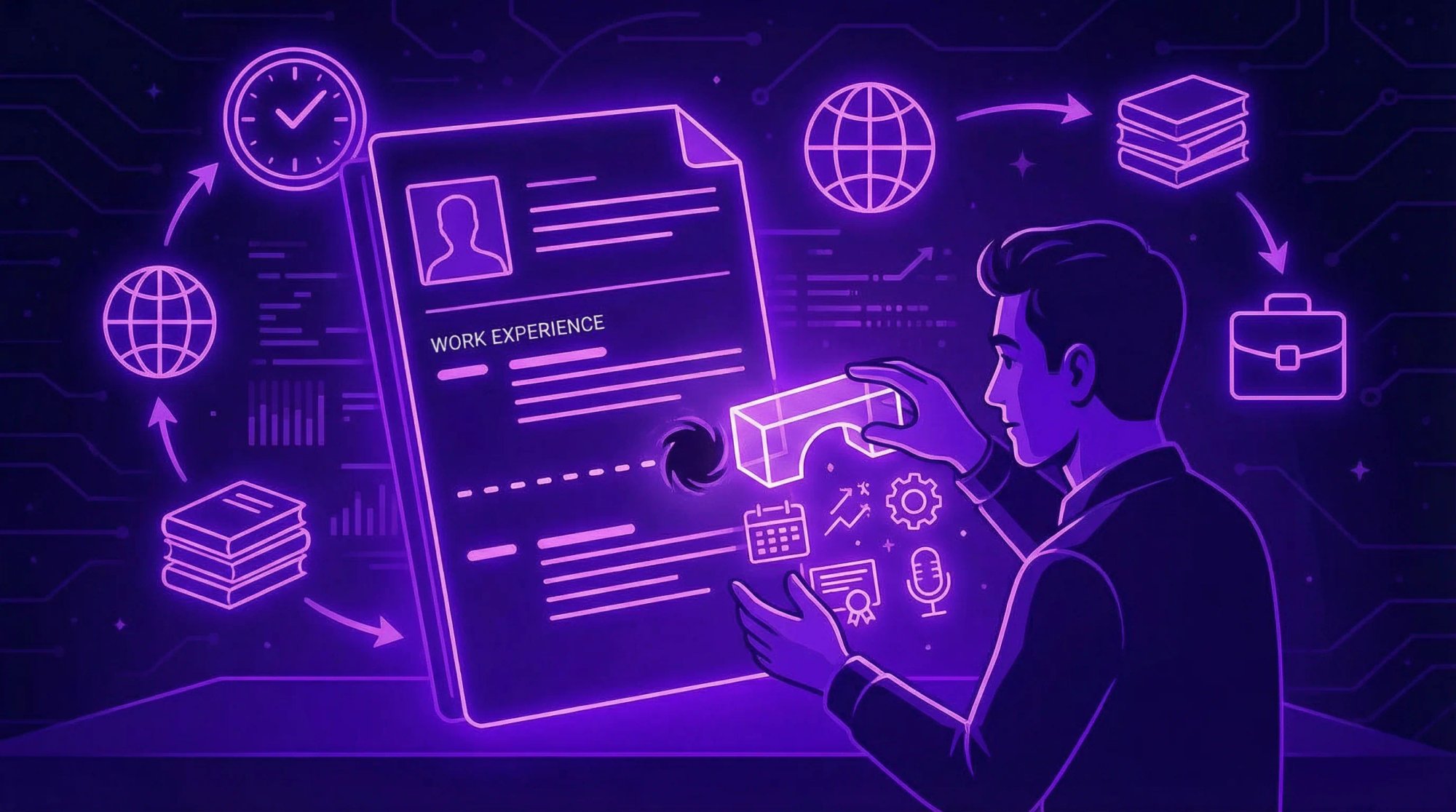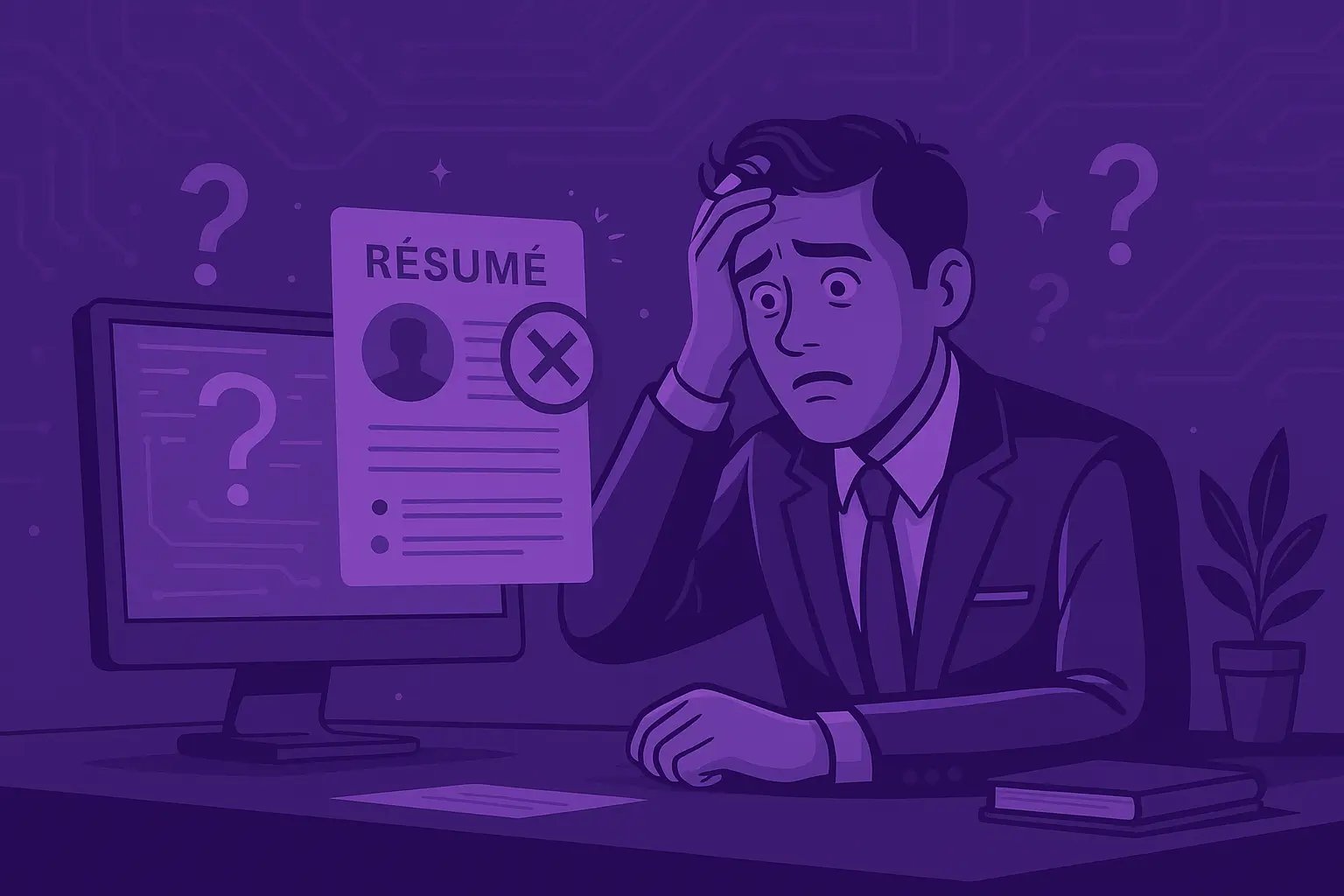6 Best Sample Email for Resume Submission Templates (2025)
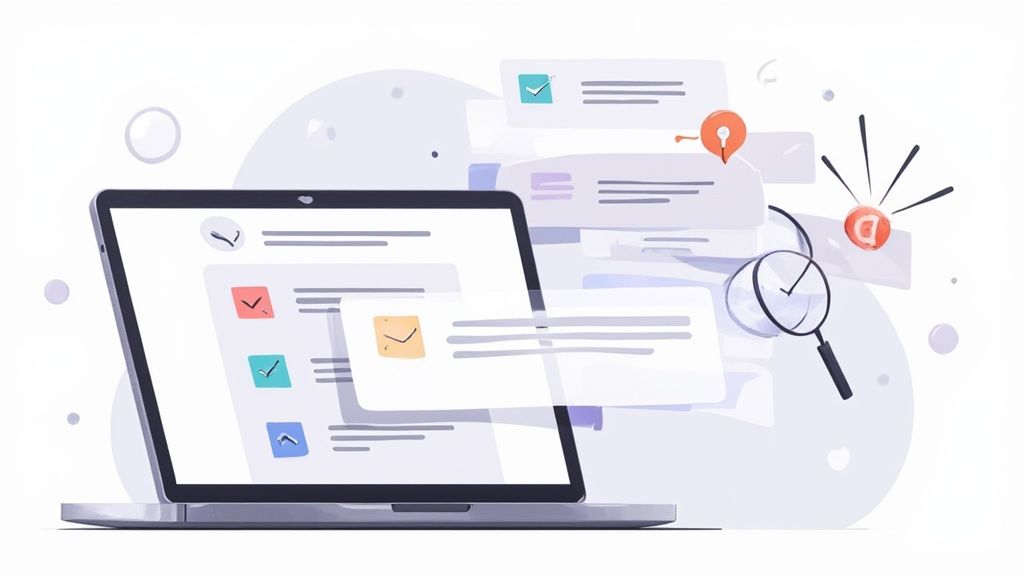
You've polished your resume until it shines and crafted a cover letter that tells your story. But what about the email that actually delivers these documents? A weak, generic, or poorly formatted message can get your entire application deleted before a hiring manager ever sees your qualifications. This is your first handshake, your initial pitch, and a critical component of your job search strategy.
In a hyper-competitive job market, the email you use to submit your resume isn't just a delivery mechanism; it's a strategic tool. It sets the tone, demonstrates your professionalism, and persuades the recipient that your attachments are worth their valuable time. A powerful email can be the deciding factor that gets your resume opened while others are ignored.
This guide moves beyond generic advice to provide you with a tactical advantage. We've compiled 6 distinct, customizable templates designed for the most common and challenging application scenarios. You will find a sample email for resume submission tailored for direct applications, cold outreach, networking referrals, career changes, and more. Each example is broken down with a strategic analysis to show you why it works and how to adapt it for your own career goals, ensuring your application gets the attention it deserves and moves to the top of the pile.
1. The Direct Professional Resume Submission Email
When your goal is to convey competence and respect for the hiring manager's time, the Direct Professional approach is your most powerful tool. This classic, no-nonsense sample email for resume submission is the industry standard for a reason: it's efficient, clear, and universally understood. It cuts through the noise by getting straight to the point, making it perfect for formal industries like finance, law, and government, as well as fast-paced tech environments where brevity is valued.
The core strategy here is clarity. You're not trying to dazzle with creative flair; you're demonstrating that you understand professional communication protocols. This email states your purpose, identifies the role you're applying for, highlights your key attachments, and provides a clear call to action. It shows you are organized, direct, and ready for business.
Anatomy of the Direct Professional Email
This email is built on a simple, effective structure that is easy for recruiters to scan and process. Every element serves a specific purpose, from the subject line to the signature.
- Subject Line: Must be precise. Use the exact job title and any job ID number listed in the posting. Example:
Application for Senior Software Engineer (Job ID #112-AB) - [Your Name]. - Salutation: Always address the hiring manager by name if possible (e.g., "Dear Ms. Rodriguez,"). If you can't find a name, "Dear Hiring Manager," is a safe, professional alternative.
- Body Paragraph: Keep it concise, ideally three to four sentences. State the position you are applying for, where you saw the opening, and briefly express your enthusiasm. Mention that your resume and cover letter are attached for their review.
- Closing: Use a professional closing like "Sincerely," or "Best regards," followed by your full name.
- Signature: Your email signature should include your full name, phone number, and a link to your LinkedIn profile.
For a quick reference on the essential structure of this email, the following summary box breaks down the key components.
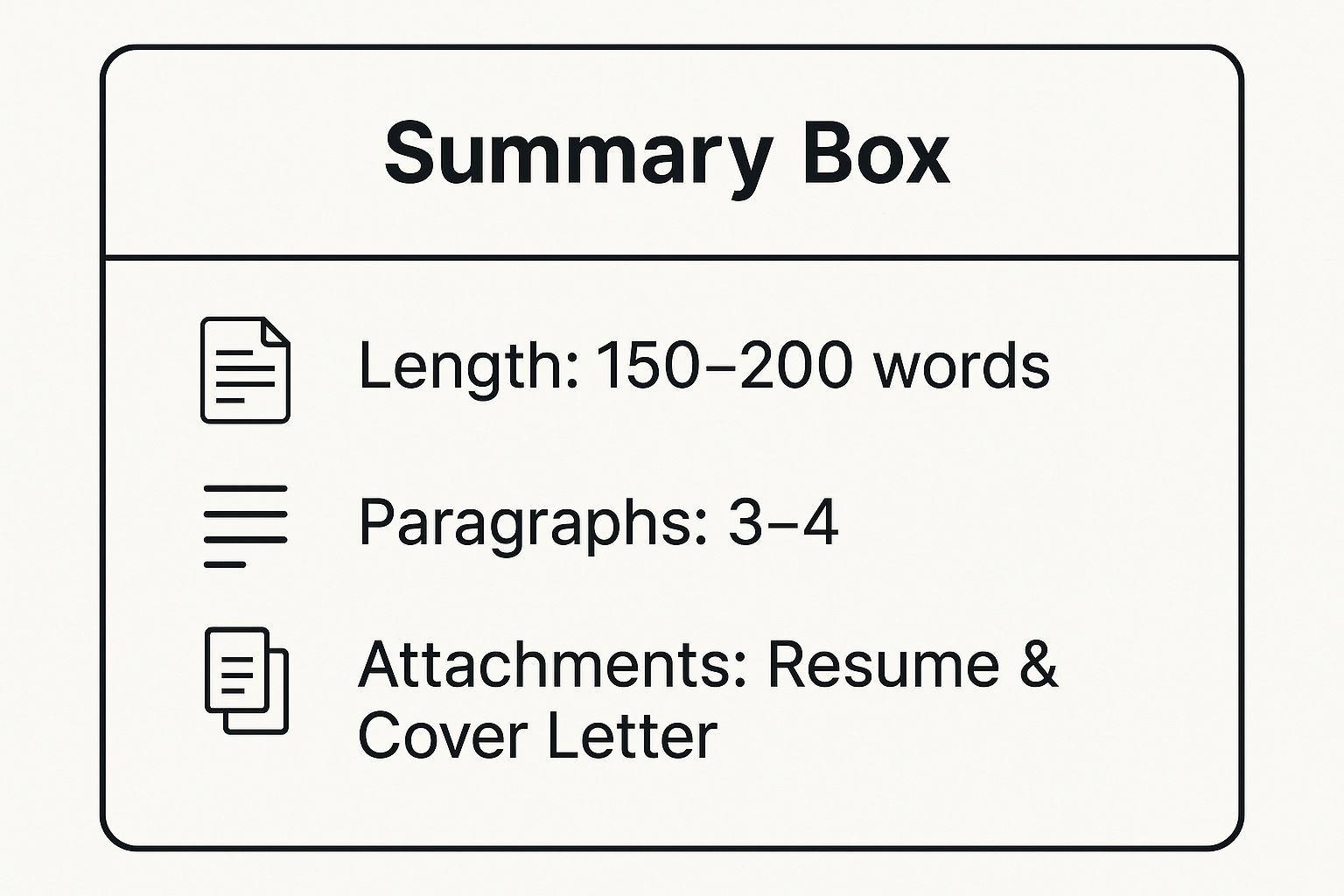
As the infographic highlights, adhering to these concise limits ensures your message is immediately digestible and positions you as a focused, professional candidate. This format respects the hiring manager's time while delivering all necessary information efficiently. For a more in-depth look at the nuances of this approach, you can learn more about crafting the perfect direct professional resume submission email.
2. The Value Proposition Resume Submission Email
When the job market is crowded, you need a sample email for resume submission that does more than just announce your application; it needs to sell your candidacy from the very first sentence. The Value Proposition approach transforms your email from a simple notification into a powerful executive summary. It immediately showcases your most relevant achievements, giving the recruiter a compelling, data-backed reason to open your resume. This strategy is perfect for roles where results are paramount, such as sales, marketing, and project management.
The core strategy is to prove your worth upfront. Instead of merely stating your interest, you provide concrete evidence of your ability to deliver value. This method demonstrates your understanding of the employer's needs and positions you as a problem-solver from the outset. It’s an assertive approach that shows confidence and a results-oriented mindset, making you a memorable applicant in a sea of generic introductions.
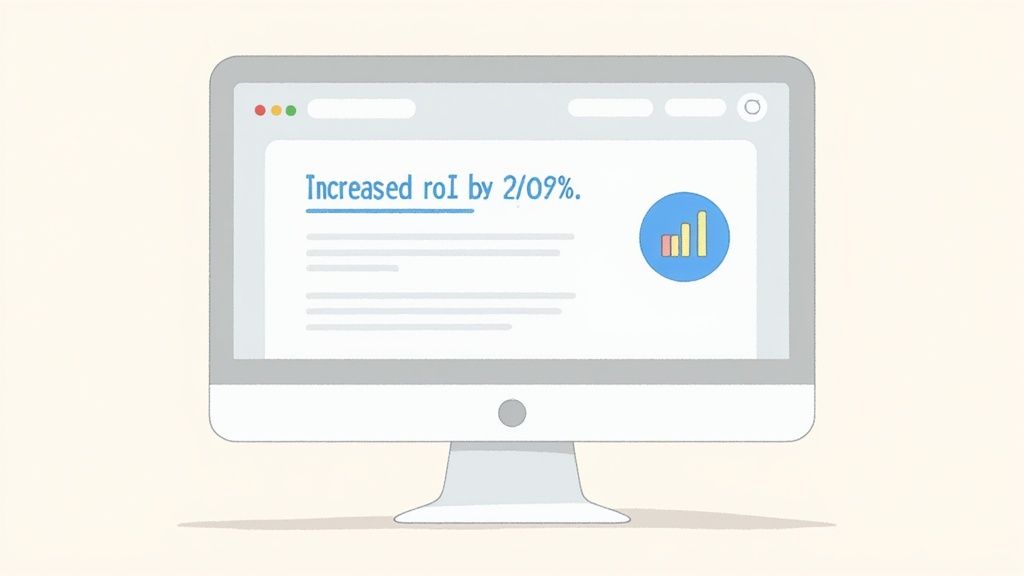
Anatomy of the Value Proposition Email
This email is structured to highlight your direct impact and alignment with the company's goals. It grabs attention by leading with results, not just intentions.
- Subject Line: Be direct but add a hook. Example:
Application for Marketing Director: 150% ROI on Digital Campaigns. - Salutation: Professional and personalized. Address the hiring manager by name (e.g., "Dear Mr. Chen,"). "Dear Hiring Team," is a solid alternative if a name is unavailable.
- Body Paragraph: This is your mini-pitch. After stating the role you're applying for, use a bulleted list to highlight 2-3 key achievements. Use metrics and strong action verbs that directly correspond to the top requirements in the job description.
- Closing: Maintain a professional tone with "Best regards," or "Sincerely,".
- Signature: Ensure it includes your full name, phone number, and a link to your LinkedIn profile for easy access.
For a deeper understanding of how to frame your accomplishments effectively, watch this breakdown of articulating your value.
As the video demonstrates, framing your experience in terms of quantifiable value is critical. This email format essentially acts as a prequel to a strong cover letter, providing a snapshot of your potential contributions. You can explore how this concept extends to your formal application documents by reviewing this example cover letter. This method ensures your email doesn't just get opened; it gets you noticed.
3. The Referral-Based Resume Submission Email
Leveraging a professional connection is one of the most effective strategies in a job search, and the Referral-Based email is designed to do just that. This type of sample email for resume submission immediately sets you apart from the general pool of applicants by using a mutual contact's name to build instant credibility. It transforms a cold outreach into a warm introduction, significantly increasing the likelihood that a hiring manager will open your email and review your resume.
The core strategy here is leveraging social proof. When a trusted colleague or industry contact refers you, it acts as a pre-endorsement of your skills and character. This approach is highly effective across all industries because it taps into the power of professional networks, making it a priority for recruiters who often trust internal recommendations above all other application sources. It signals that you are a known and vetted quantity, which is a powerful advantage.
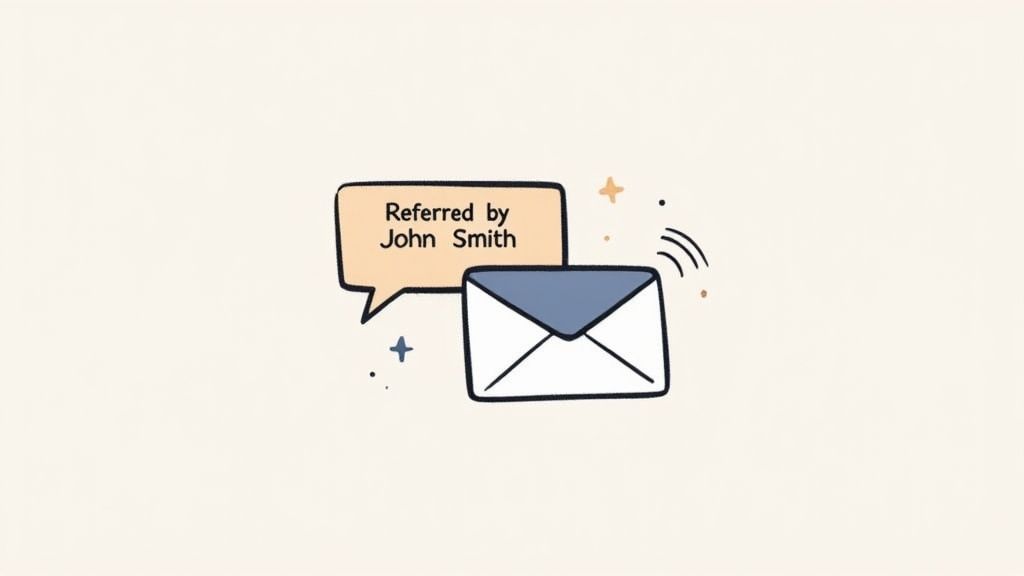
Anatomy of the Referral-Based Email
This email must strike a careful balance between professionalism and the personal connection you're highlighting. Each component is designed to capitalize on the referral without seeming overly familiar or presumptuous.
- Subject Line: Lead with the referral's name to grab attention immediately. Example:
Referral from [Referrer's Name] for [Job Title] Position. - Salutation: Use a formal and respectful greeting, even with the referral. "Dear [Hiring Manager's Name]," remains the standard.
- Body Paragraph: The opening sentence is critical. State the referrer's name and your connection to them right away. For example, "My colleague, [Referrer's Name], recommended I reach out to you regarding the [Job Title] opening." Follow this by briefly connecting your qualifications to the role's needs before mentioning your attached resume and cover letter.
- Closing: Maintain a professional tone with "Sincerely," or "Best regards,".
- Signature: Include your full name, phone number, and LinkedIn profile link. You might also consider asking your referrer if you can copy them on the email to keep them in the loop.
For a quick reference on the essential structure of this email, the following summary box breaks down the key components.
As the infographic highlights, the key is to mention the referrer early and clearly. This approach turns a standard application into a priority item in a busy hiring manager's inbox. To explore how to best utilize your network, you can learn more about crafting the perfect referral-based resume submission email.
4. The Cold Outreach Resume Submission Email
When there’s no job posting but you know you can bring value to a company, the Cold Outreach approach is your proactive strategy for getting noticed. This sample email for resume submission is designed for the ambitious job seeker who targets opportunities rather than waiting for them. It’s perfect for reaching out to high-growth startups, companies that recently received funding, or departments you’ve identified as a perfect fit for your skills, even if they aren't actively hiring.
The core strategy here is to demonstrate initiative and deep research. You're not just another applicant; you're a problem-solver who has already identified how you can contribute to the company's goals. This email shows you've done your homework, understand the company's challenges or recent successes, and have a clear vision for how you can add immediate value. It positions you as a strategic thinker, not just a candidate.
Anatomy of the Cold Outreach Email
This email is built on a foundation of research, personalization, and a compelling value proposition. It grabs attention by being highly relevant to the recipient and their organization's current situation.
- Subject Line: Must be intriguing and personalized. Avoid generic "Application" titles. Example:
Inquiry from a Marketing Automation Specialist re: [Company Name]'s recent Series B funding. - Salutation: Addressing the correct person is critical. Find the department head or a relevant manager (e.g., "Dear Mr. Chen,"). Research on LinkedIn or the company website is non-negotiable here.
- Body Paragraph: Start with a specific, recent company achievement or project you admire. Connect this directly to your expertise and propose a concrete way you could contribute. For example, mention their expansion into a new market and how your experience aligns with that goal. Keep the focus on their needs, not your job search.
- Closing: Propose a brief, low-commitment next step. Instead of asking for a job, request a 15-minute conversation to discuss your ideas. Use a professional closing like "Best regards,".
- Signature: Include your full name, phone number, a concise title (e.g., "Logistics & Supply Chain Professional"), and your LinkedIn profile link.
For a quick reference on the essential structure of this email, the following summary box breaks down the key components.
Key Components for Cold Outreach:
- Personalized Hook: Start with a specific company achievement, news, or project.
- Value Proposition: Clearly state how your skills can address a potential need or opportunity.
- Call to Action: Request a brief, informational chat, not a job interview.
- Attachment: Attach your resume, but frame it as providing more context for your background.
This format shifts the dynamic from you asking for a job to you offering a solution. By focusing on the company’s goals, you make a powerful first impression. Remember, a polite follow-up is key if you don't hear back, and you can learn more about mastering the job application follow-up email.
5. The Follow-Up Resume Submission Email
When your initial application vanishes into the digital void, the Follow-Up Resume Submission Email is your strategic tool to re-engage. This sample email for resume submission is designed for proactive candidates who understand that persistence, when executed politely, can make a significant difference. It’s perfect for situations where you've applied via an online portal or after meeting a recruiter and want to ensure your application hasn't been overlooked.
The core strategy here is to demonstrate continued enthusiasm and professionalism without being pushy. You are not just "checking in"; you are tactfully bringing your name back to the top of the inbox, reinforcing your interest, and potentially adding new, relevant information. This email shows you are diligent, genuinely interested in the role, and possess the soft skills to navigate professional communications gracefully.
Anatomy of the Follow-Up Email
This email is built on a foundation of respect for the recruiter’s time while strategically reminding them of your value. Each component is crafted to be brief, impactful, and easy to act on.
- Subject Line: Clarity is crucial. It must connect this email to your original application. Use a format like:
Following Up on Application for [Job Title] - [Your Name]. - Salutation: Re-use the same salutation from your initial contact. "Dear Ms. Rodriguez," is ideal. If you used "Dear Hiring Manager," before, stick with it.
- Body Paragraph: Keep this extremely concise, aiming for three to four sentences. Gently remind them when and where you applied, reiterate your strong interest in the role, and briefly mention a key qualification or a new accomplishment that reinforces your fit.
- Closing: Maintain a professional tone with "Sincerely," or "Best regards," followed by your full name.
- Signature: Ensure your signature is complete with your full name, phone number, and a link to your LinkedIn profile for easy reference.
For a quick reference on the essential structure of this email, the following summary box breaks down the key components.
As the infographic highlights, brevity is your greatest asset. Waiting at least one week shows respect for their process, while adding a new piece of information prevents your message from being a simple nudge. This approach positions you as a thoughtful and engaged candidate. To master the art of this crucial communication, you can discover more about crafting the perfect follow-up application letter.
6. The Career Change Resume Submission Email
Transitioning to a new industry requires a specialized approach that directly addresses the recruiter's primary question: "Why should I consider someone without direct experience?" This sample email for resume submission is crafted to preemptively answer that question by framing your unique background as a distinct advantage, not a liability. It's designed for professionals like a teacher moving into corporate training or a military veteran entering civilian project management, where transferable skills are the bridge to a new career.
The core strategy is to connect the dots for the hiring manager. Instead of letting them guess how your past experience in sales applies to a customer success role, you explicitly state the connection. This email moves beyond a simple job application; it presents a compelling narrative about your career pivot, demonstrating self-awareness, motivation, and a clear understanding of how your skills meet their needs.
Anatomy of the Career Change Email
This email must be strategically structured to build a strong, logical case for your candidacy. Each component works to reframe your experience and highlight your potential.
- Subject Line: Be clear but also hint at your value. Example:
Application for Instructional Designer - Experienced Educator with Curriculum Development Skills. This immediately frames your background positively. - Salutation: Standard professional etiquette applies. "Dear [Hiring Manager Name]," is best. "Dear Hiring Team," is a solid alternative if a specific name isn't available.
- Body Paragraph: This is longer and more narrative-driven. The first sentence should state the role you're applying for. The next two to three sentences must create a powerful "bridge statement" connecting your past expertise (e.g., "my 10 years as a high school teacher") to the new role's requirements (e.g., "honed my ability to design engaging learning modules and assess performance outcomes"). Mention key transferable skills and any recent certifications or training.
- Closing: Maintain a professional tone with "Sincerely," or "Best regards,".
- Signature: Include your full name, phone number, and a link to your LinkedIn profile, ensuring it reflects your new career direction.
This format proactively addresses potential recruiter hesitations by showcasing your relevant skills and passion for the new field. For those navigating this significant professional shift, you can get more guidance on how to pivot careers effectively.
6 Resume Submission Email Types Compared
Automate Your Success and Secure Your Next Interview
You now have a powerful toolkit of six distinct, strategically crafted email templates. We've dissected everything from the direct professional submission to the nuanced career-change pitch, giving you the architecture for a compelling introduction. But the real takeaway isn’t just copying and pasting these examples; it's understanding the why behind each word choice, each subject line, and each call to action.
The common thread weaving through every successful sample email for resume submission is customization fueled by strategic intent. A generic email blasts a resume into the void. A strategic email, however, serves as a guided missile, precision-targeted to solve a specific problem for a specific person. It respects the reader's time, demonstrates your value, and makes their decision to open your resume an easy one.
From Template to Triumph: Your Actionable Next Steps
Mastering the art of the submission email is about transforming a passive action, sending a resume, into an active, persuasive engagement. To put these lessons into practice immediately, focus on these core principles:
- Audit Your Approach: Before sending your next application, stop and ask: which of these templates best fits this specific situation? Are you leveraging a referral? Pitching a unique value proposition? Acknowledging a career pivot? Choose your framework with purpose.
- Quantify Your Impact: Move beyond listing responsibilities. As shown in the Value Proposition and Career Change examples, incorporating specific metrics (e.g., "increased efficiency by 15%," "managed a $50K budget") provides concrete proof of your capabilities.
- Personalize Beyond the Name: True personalization goes deeper than
[Hiring Manager Name]. It means referencing company projects, recent news, or specific challenges mentioned in the job description. This shows you’ve done your homework and are genuinely invested.
Remember, the goal of your email is not just to deliver your resume. It is to create a compelling, professional, and human connection that makes the recruiter want to learn more about you. It's the first test of your communication skills, your attention to detail, and your ability to present yourself as the ideal solution to their needs. By internalizing these strategies, you are no longer just another applicant in a crowded inbox; you are a standout candidate who commands attention and respect from the very first click.
Tired of manually customizing every single application? Let technology handle the heavy lifting. AIApply leverages advanced AI to generate perfectly tailored resume submission emails and follow-up sequences based on your profile and the specific job description. Stop guessing and start landing more interviews by visiting AIApply today.
You've polished your resume until it shines and crafted a cover letter that tells your story. But what about the email that actually delivers these documents? A weak, generic, or poorly formatted message can get your entire application deleted before a hiring manager ever sees your qualifications. This is your first handshake, your initial pitch, and a critical component of your job search strategy.
In a hyper-competitive job market, the email you use to submit your resume isn't just a delivery mechanism; it's a strategic tool. It sets the tone, demonstrates your professionalism, and persuades the recipient that your attachments are worth their valuable time. A powerful email can be the deciding factor that gets your resume opened while others are ignored.
This guide moves beyond generic advice to provide you with a tactical advantage. We've compiled 6 distinct, customizable templates designed for the most common and challenging application scenarios. You will find a sample email for resume submission tailored for direct applications, cold outreach, networking referrals, career changes, and more. Each example is broken down with a strategic analysis to show you why it works and how to adapt it for your own career goals, ensuring your application gets the attention it deserves and moves to the top of the pile.
1. The Direct Professional Resume Submission Email
When your goal is to convey competence and respect for the hiring manager's time, the Direct Professional approach is your most powerful tool. This classic, no-nonsense sample email for resume submission is the industry standard for a reason: it's efficient, clear, and universally understood. It cuts through the noise by getting straight to the point, making it perfect for formal industries like finance, law, and government, as well as fast-paced tech environments where brevity is valued.
The core strategy here is clarity. You're not trying to dazzle with creative flair; you're demonstrating that you understand professional communication protocols. This email states your purpose, identifies the role you're applying for, highlights your key attachments, and provides a clear call to action. It shows you are organized, direct, and ready for business.
Anatomy of the Direct Professional Email
This email is built on a simple, effective structure that is easy for recruiters to scan and process. Every element serves a specific purpose, from the subject line to the signature.
- Subject Line: Must be precise. Use the exact job title and any job ID number listed in the posting. Example:
Application for Senior Software Engineer (Job ID #112-AB) - [Your Name]. - Salutation: Always address the hiring manager by name if possible (e.g., "Dear Ms. Rodriguez,"). If you can't find a name, "Dear Hiring Manager," is a safe, professional alternative.
- Body Paragraph: Keep it concise, ideally three to four sentences. State the position you are applying for, where you saw the opening, and briefly express your enthusiasm. Mention that your resume and cover letter are attached for their review.
- Closing: Use a professional closing like "Sincerely," or "Best regards," followed by your full name.
- Signature: Your email signature should include your full name, phone number, and a link to your LinkedIn profile.
For a quick reference on the essential structure of this email, the following summary box breaks down the key components.

As the infographic highlights, adhering to these concise limits ensures your message is immediately digestible and positions you as a focused, professional candidate. This format respects the hiring manager's time while delivering all necessary information efficiently. For a more in-depth look at the nuances of this approach, you can learn more about crafting the perfect direct professional resume submission email.
2. The Value Proposition Resume Submission Email
When the job market is crowded, you need a sample email for resume submission that does more than just announce your application; it needs to sell your candidacy from the very first sentence. The Value Proposition approach transforms your email from a simple notification into a powerful executive summary. It immediately showcases your most relevant achievements, giving the recruiter a compelling, data-backed reason to open your resume. This strategy is perfect for roles where results are paramount, such as sales, marketing, and project management.
The core strategy is to prove your worth upfront. Instead of merely stating your interest, you provide concrete evidence of your ability to deliver value. This method demonstrates your understanding of the employer's needs and positions you as a problem-solver from the outset. It’s an assertive approach that shows confidence and a results-oriented mindset, making you a memorable applicant in a sea of generic introductions.

Anatomy of the Value Proposition Email
This email is structured to highlight your direct impact and alignment with the company's goals. It grabs attention by leading with results, not just intentions.
- Subject Line: Be direct but add a hook. Example:
Application for Marketing Director: 150% ROI on Digital Campaigns. - Salutation: Professional and personalized. Address the hiring manager by name (e.g., "Dear Mr. Chen,"). "Dear Hiring Team," is a solid alternative if a name is unavailable.
- Body Paragraph: This is your mini-pitch. After stating the role you're applying for, use a bulleted list to highlight 2-3 key achievements. Use metrics and strong action verbs that directly correspond to the top requirements in the job description.
- Closing: Maintain a professional tone with "Best regards," or "Sincerely,".
- Signature: Ensure it includes your full name, phone number, and a link to your LinkedIn profile for easy access.
For a deeper understanding of how to frame your accomplishments effectively, watch this breakdown of articulating your value.
As the video demonstrates, framing your experience in terms of quantifiable value is critical. This email format essentially acts as a prequel to a strong cover letter, providing a snapshot of your potential contributions. You can explore how this concept extends to your formal application documents by reviewing this example cover letter. This method ensures your email doesn't just get opened; it gets you noticed.
3. The Referral-Based Resume Submission Email
Leveraging a professional connection is one of the most effective strategies in a job search, and the Referral-Based email is designed to do just that. This type of sample email for resume submission immediately sets you apart from the general pool of applicants by using a mutual contact's name to build instant credibility. It transforms a cold outreach into a warm introduction, significantly increasing the likelihood that a hiring manager will open your email and review your resume.
The core strategy here is leveraging social proof. When a trusted colleague or industry contact refers you, it acts as a pre-endorsement of your skills and character. This approach is highly effective across all industries because it taps into the power of professional networks, making it a priority for recruiters who often trust internal recommendations above all other application sources. It signals that you are a known and vetted quantity, which is a powerful advantage.

Anatomy of the Referral-Based Email
This email must strike a careful balance between professionalism and the personal connection you're highlighting. Each component is designed to capitalize on the referral without seeming overly familiar or presumptuous.
- Subject Line: Lead with the referral's name to grab attention immediately. Example:
Referral from [Referrer's Name] for [Job Title] Position. - Salutation: Use a formal and respectful greeting, even with the referral. "Dear [Hiring Manager's Name]," remains the standard.
- Body Paragraph: The opening sentence is critical. State the referrer's name and your connection to them right away. For example, "My colleague, [Referrer's Name], recommended I reach out to you regarding the [Job Title] opening." Follow this by briefly connecting your qualifications to the role's needs before mentioning your attached resume and cover letter.
- Closing: Maintain a professional tone with "Sincerely," or "Best regards,".
- Signature: Include your full name, phone number, and LinkedIn profile link. You might also consider asking your referrer if you can copy them on the email to keep them in the loop.
For a quick reference on the essential structure of this email, the following summary box breaks down the key components.
As the infographic highlights, the key is to mention the referrer early and clearly. This approach turns a standard application into a priority item in a busy hiring manager's inbox. To explore how to best utilize your network, you can learn more about crafting the perfect referral-based resume submission email.
4. The Cold Outreach Resume Submission Email
When there’s no job posting but you know you can bring value to a company, the Cold Outreach approach is your proactive strategy for getting noticed. This sample email for resume submission is designed for the ambitious job seeker who targets opportunities rather than waiting for them. It’s perfect for reaching out to high-growth startups, companies that recently received funding, or departments you’ve identified as a perfect fit for your skills, even if they aren't actively hiring.
The core strategy here is to demonstrate initiative and deep research. You're not just another applicant; you're a problem-solver who has already identified how you can contribute to the company's goals. This email shows you've done your homework, understand the company's challenges or recent successes, and have a clear vision for how you can add immediate value. It positions you as a strategic thinker, not just a candidate.
Anatomy of the Cold Outreach Email
This email is built on a foundation of research, personalization, and a compelling value proposition. It grabs attention by being highly relevant to the recipient and their organization's current situation.
- Subject Line: Must be intriguing and personalized. Avoid generic "Application" titles. Example:
Inquiry from a Marketing Automation Specialist re: [Company Name]'s recent Series B funding. - Salutation: Addressing the correct person is critical. Find the department head or a relevant manager (e.g., "Dear Mr. Chen,"). Research on LinkedIn or the company website is non-negotiable here.
- Body Paragraph: Start with a specific, recent company achievement or project you admire. Connect this directly to your expertise and propose a concrete way you could contribute. For example, mention their expansion into a new market and how your experience aligns with that goal. Keep the focus on their needs, not your job search.
- Closing: Propose a brief, low-commitment next step. Instead of asking for a job, request a 15-minute conversation to discuss your ideas. Use a professional closing like "Best regards,".
- Signature: Include your full name, phone number, a concise title (e.g., "Logistics & Supply Chain Professional"), and your LinkedIn profile link.
For a quick reference on the essential structure of this email, the following summary box breaks down the key components.
Key Components for Cold Outreach:
- Personalized Hook: Start with a specific company achievement, news, or project.
- Value Proposition: Clearly state how your skills can address a potential need or opportunity.
- Call to Action: Request a brief, informational chat, not a job interview.
- Attachment: Attach your resume, but frame it as providing more context for your background.
This format shifts the dynamic from you asking for a job to you offering a solution. By focusing on the company’s goals, you make a powerful first impression. Remember, a polite follow-up is key if you don't hear back, and you can learn more about mastering the job application follow-up email.
5. The Follow-Up Resume Submission Email
When your initial application vanishes into the digital void, the Follow-Up Resume Submission Email is your strategic tool to re-engage. This sample email for resume submission is designed for proactive candidates who understand that persistence, when executed politely, can make a significant difference. It’s perfect for situations where you've applied via an online portal or after meeting a recruiter and want to ensure your application hasn't been overlooked.
The core strategy here is to demonstrate continued enthusiasm and professionalism without being pushy. You are not just "checking in"; you are tactfully bringing your name back to the top of the inbox, reinforcing your interest, and potentially adding new, relevant information. This email shows you are diligent, genuinely interested in the role, and possess the soft skills to navigate professional communications gracefully.
Anatomy of the Follow-Up Email
This email is built on a foundation of respect for the recruiter’s time while strategically reminding them of your value. Each component is crafted to be brief, impactful, and easy to act on.
- Subject Line: Clarity is crucial. It must connect this email to your original application. Use a format like:
Following Up on Application for [Job Title] - [Your Name]. - Salutation: Re-use the same salutation from your initial contact. "Dear Ms. Rodriguez," is ideal. If you used "Dear Hiring Manager," before, stick with it.
- Body Paragraph: Keep this extremely concise, aiming for three to four sentences. Gently remind them when and where you applied, reiterate your strong interest in the role, and briefly mention a key qualification or a new accomplishment that reinforces your fit.
- Closing: Maintain a professional tone with "Sincerely," or "Best regards," followed by your full name.
- Signature: Ensure your signature is complete with your full name, phone number, and a link to your LinkedIn profile for easy reference.
For a quick reference on the essential structure of this email, the following summary box breaks down the key components.
As the infographic highlights, brevity is your greatest asset. Waiting at least one week shows respect for their process, while adding a new piece of information prevents your message from being a simple nudge. This approach positions you as a thoughtful and engaged candidate. To master the art of this crucial communication, you can discover more about crafting the perfect follow-up application letter.
6. The Career Change Resume Submission Email
Transitioning to a new industry requires a specialized approach that directly addresses the recruiter's primary question: "Why should I consider someone without direct experience?" This sample email for resume submission is crafted to preemptively answer that question by framing your unique background as a distinct advantage, not a liability. It's designed for professionals like a teacher moving into corporate training or a military veteran entering civilian project management, where transferable skills are the bridge to a new career.
The core strategy is to connect the dots for the hiring manager. Instead of letting them guess how your past experience in sales applies to a customer success role, you explicitly state the connection. This email moves beyond a simple job application; it presents a compelling narrative about your career pivot, demonstrating self-awareness, motivation, and a clear understanding of how your skills meet their needs.
Anatomy of the Career Change Email
This email must be strategically structured to build a strong, logical case for your candidacy. Each component works to reframe your experience and highlight your potential.
- Subject Line: Be clear but also hint at your value. Example:
Application for Instructional Designer - Experienced Educator with Curriculum Development Skills. This immediately frames your background positively. - Salutation: Standard professional etiquette applies. "Dear [Hiring Manager Name]," is best. "Dear Hiring Team," is a solid alternative if a specific name isn't available.
- Body Paragraph: This is longer and more narrative-driven. The first sentence should state the role you're applying for. The next two to three sentences must create a powerful "bridge statement" connecting your past expertise (e.g., "my 10 years as a high school teacher") to the new role's requirements (e.g., "honed my ability to design engaging learning modules and assess performance outcomes"). Mention key transferable skills and any recent certifications or training.
- Closing: Maintain a professional tone with "Sincerely," or "Best regards,".
- Signature: Include your full name, phone number, and a link to your LinkedIn profile, ensuring it reflects your new career direction.
This format proactively addresses potential recruiter hesitations by showcasing your relevant skills and passion for the new field. For those navigating this significant professional shift, you can get more guidance on how to pivot careers effectively.
6 Resume Submission Email Types Compared
Automate Your Success and Secure Your Next Interview
You now have a powerful toolkit of six distinct, strategically crafted email templates. We've dissected everything from the direct professional submission to the nuanced career-change pitch, giving you the architecture for a compelling introduction. But the real takeaway isn’t just copying and pasting these examples; it's understanding the why behind each word choice, each subject line, and each call to action.
The common thread weaving through every successful sample email for resume submission is customization fueled by strategic intent. A generic email blasts a resume into the void. A strategic email, however, serves as a guided missile, precision-targeted to solve a specific problem for a specific person. It respects the reader's time, demonstrates your value, and makes their decision to open your resume an easy one.
From Template to Triumph: Your Actionable Next Steps
Mastering the art of the submission email is about transforming a passive action, sending a resume, into an active, persuasive engagement. To put these lessons into practice immediately, focus on these core principles:
- Audit Your Approach: Before sending your next application, stop and ask: which of these templates best fits this specific situation? Are you leveraging a referral? Pitching a unique value proposition? Acknowledging a career pivot? Choose your framework with purpose.
- Quantify Your Impact: Move beyond listing responsibilities. As shown in the Value Proposition and Career Change examples, incorporating specific metrics (e.g., "increased efficiency by 15%," "managed a $50K budget") provides concrete proof of your capabilities.
- Personalize Beyond the Name: True personalization goes deeper than
[Hiring Manager Name]. It means referencing company projects, recent news, or specific challenges mentioned in the job description. This shows you’ve done your homework and are genuinely invested.
Remember, the goal of your email is not just to deliver your resume. It is to create a compelling, professional, and human connection that makes the recruiter want to learn more about you. It's the first test of your communication skills, your attention to detail, and your ability to present yourself as the ideal solution to their needs. By internalizing these strategies, you are no longer just another applicant in a crowded inbox; you are a standout candidate who commands attention and respect from the very first click.
Tired of manually customizing every single application? Let technology handle the heavy lifting. AIApply leverages advanced AI to generate perfectly tailored resume submission emails and follow-up sequences based on your profile and the specific job description. Stop guessing and start landing more interviews by visiting AIApply today.
Don't miss out on
your next opportunity.
Create and send applications in seconds, not hours.






